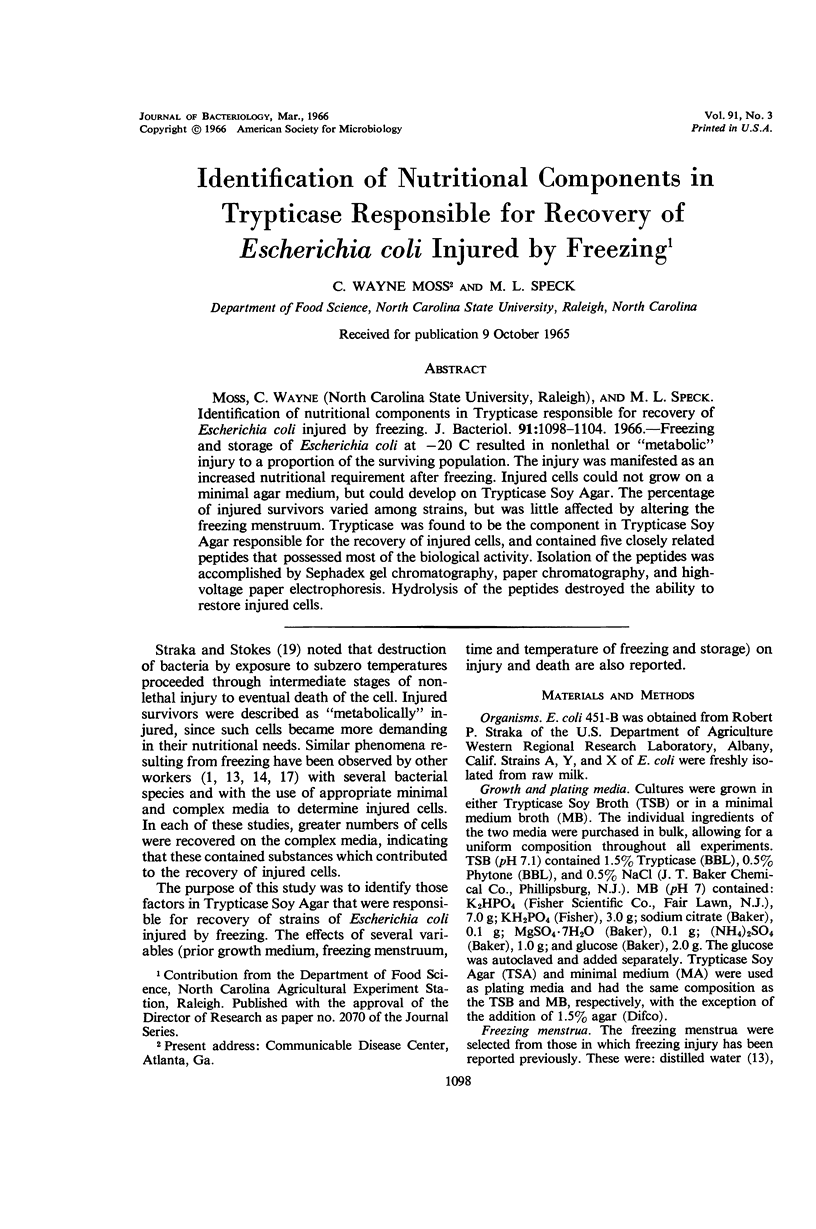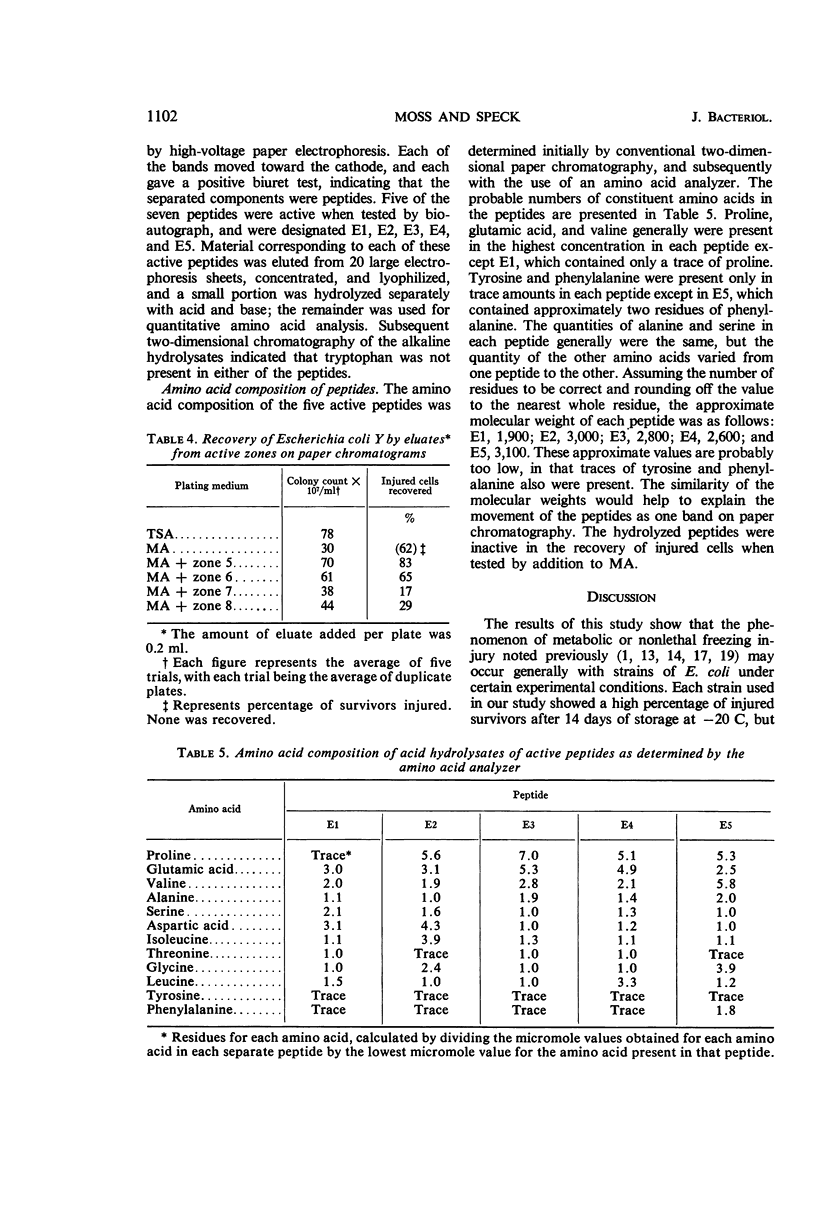Abstract
Moss, C. Wayne (North Carolina State University, Raleigh), and M. L. Speck. Identification of nutritional components in Trypticase responsible for recovery of Escherichia coli injured by freezing. J. Bacteriol. 91:1098–1104. 1966.—Freezing and storage of Escherichia coli at −20 C resulted in nonlethal or “metabolic” injury to a proportion of the surviving population. The injury was manifested as an increased nutritional requirement after freezing. Injured cells could not grow on a minimal agar medium, but could develop on Trypticase Soy Agar. The percentage of injured survivors varied among strains, but was little affected by altering the freezing menstruum. Trypticase was found to be the component in Trypticase Soy Agar responsible for the recovery of injured cells, and contained five closely related peptides that possessed most of the biological activity. Isolation of the peptides was accomplished by Sephadex gel chromatography, paper chromatography, and high-voltage paper electrophoresis. Hydrolysis of the peptides destroyed the ability to restore injured cells.
Full text
PDF






Selected References
These references are in PubMed. This may not be the complete list of references from this article.
- ARPAI J. Nonlethal freezing injury to metabolism and motility of Pseudomonas fluorescens and Escherichia coli. Appl Microbiol. 1962 Jul;10:297–301. doi: 10.1128/am.10.4.297-301.1962. [DOI] [PMC free article] [PubMed] [Google Scholar]
- GORDON D. F., Jr, SPECK M. L. BITTER PEPTIDE ISOLATED FROM MILK CULTURES OF STREPTOCOCCUS CREMORIS. Appl Microbiol. 1965 Jul;13:537–542. doi: 10.1128/am.13.4.537-542.1965. [DOI] [PMC free article] [PubMed] [Google Scholar]
- KATZ A. M., DREYER W. J., ANFINSEN C. B. Peptide separation by two-dimensional chromatography and electrophoresis. J Biol Chem. 1959 Nov;234:2897–2900. [PubMed] [Google Scholar]
- KENNEDY H. E., SPECK M. L., AURAND L. W. Studies on a growth stimulant from corn steep using Lactobacillus casei. J Bacteriol. 1955 Jul;70(1):70–77. doi: 10.1128/jb.70.1.70-77.1955. [DOI] [PMC free article] [PubMed] [Google Scholar]
- KIHARA H., KLATT O. A., SNELL E. E. Peptides and bacterial growth. III. Utilization of tyrosine and tyrosine peptides by Streptococcus faecalis. J Biol Chem. 1952 May;197(2):801–807. [PubMed] [Google Scholar]
- LEVINE E. M., SIMMONDS S. Metabolite uptake by serineglycine auxotrophs of Escherichia coli. J Biol Chem. 1960 Oct;235:2902–2909. [PubMed] [Google Scholar]
- MAZUR P. Physical factors implicated in the death of microorganisms at subzero temperatures. Ann N Y Acad Sci. 1960 Apr 13;85:610–629. doi: 10.1111/j.1749-6632.1960.tb49986.x. [DOI] [PubMed] [Google Scholar]
- MEINHART J. O., SIMMONDS S. Metabolism of serine and glycine peptides by mutents of Escherichia coli strain K-12. J Biol Chem. 1955 Sep;216(1):51–65. [PubMed] [Google Scholar]
- MOSS C. W., SPECK M. L. Injury and death of Streptococcus lactis due to freezing and frozen storage. Appl Microbiol. 1963 Jul;11:326–329. doi: 10.1128/am.11.4.326-329.1963. [DOI] [PMC free article] [PubMed] [Google Scholar]
- Morris D. L. Quantitative Determination of Carbohydrates With Dreywood's Anthrone Reagent. Science. 1948 Mar 5;107(2775):254–255. doi: 10.1126/science.107.2775.254. [DOI] [PubMed] [Google Scholar]
- NAKAMURA M., DAWSON D. A. Role of suspending and recovery media in the survival of frozen Shigella sonnei. Appl Microbiol. 1962 Jan;10:40–43. doi: 10.1128/am.10.1.40-43.1962. [DOI] [PMC free article] [PubMed] [Google Scholar]
- PETERS V. J., PRESCOTT J. M., SNELL E. E. Peptides and bacterial growth. IV. Histidine peptides as growth factors for Lactobacillus delbrueckii 9649. J Biol Chem. 1953 Jun;202(2):521–532. [PubMed] [Google Scholar]
- PHILLIPS A. W., GIBBS P. A. Techniques for the fractionation of microbiologically active peptides derived from casein. Biochem J. 1961 Dec;81:551–556. doi: 10.1042/bj0810551. [DOI] [PMC free article] [PubMed] [Google Scholar]
- STONE D., HOBERMAN H. D. Utilization of proline peptides by a prolineless mutant of Escherichia coli. J Biol Chem. 1953 May;202(1):203–212. [PubMed] [Google Scholar]
- STRAKA R. P., STOKES J. L. Metabolic injury to bacteria at low temperatures. J Bacteriol. 1959 Aug;78:181–185. doi: 10.1128/jb.78.2.181-185.1959. [DOI] [PMC free article] [PubMed] [Google Scholar]
- WAGMAN J. Evidence of cytoplasmic membrane injury in the drying of bacteria. J Bacteriol. 1960 Oct;80:558–564. doi: 10.1128/jb.80.4.558-564.1960. [DOI] [PMC free article] [PubMed] [Google Scholar]
- Weiser R. S., Osterud C. M. Studies on the Death of Bacteria at Low Temperatures: I. The Influence of the Intensity of the Freezing Temperature, Repeated Fluctuations of Temperature, and the Period of Exposure to Freezing Temperatures on the Mortality of Escherichia coli. J Bacteriol. 1945 Oct;50(4):413–439. [PMC free article] [PubMed] [Google Scholar]


